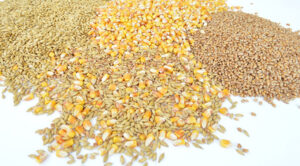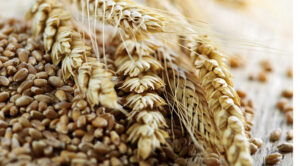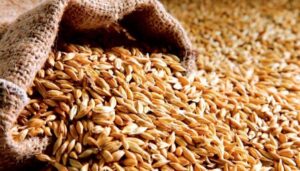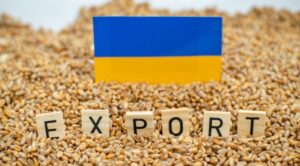
The U.S. Department of Agriculture (USDA) has adjusted its forecast for Ukraine’s wheat exports for the 2024/25 marketing year (MY, July 2024-June 2025) and lowered it by 0.5 million tons to 15.5 million tons, and corn by 1 million tons to 22 million tons.
The updated USDA forecast for February indicates that in 2024/25 MY wheat and corn production in Ukraine will remain at 22.9 mln tonnes and 26.5 mln tonnes, respectively.
At the same time, a slight increase in wheat production and consumption is expected, however, according to USDA, trade volumes and ending stocks will be lower. Accordingly, the forecast for global wheat production was increased by 0.6 million tons to 793.8 million tons, due to increased production in Kazakhstan (+0.6 million tons, to 18.6 million tons) and Argentina (+0.2 million tons, to 17.7 million tons).
Global wheat consumption will also increase by 1.8 mln tonnes to 803.7 mln tonnes due to higher use of feed grains and transitional residues in the EU, Kazakhstan, Thailand and Ukraine.
At the same time, the global wheat trade will decrease by 3 million tons to 209 million tons due to the decline in exports by the EU (-1.0 million tons, to 28.0 million tons), Mexico, Russia (-0.5 million tons, to 45.5 million tons), Turkey and Ukraine (-0.5 million tons, to 15.5 million tons). The largest reduction is expected in China – by 2.5 million tons, to 8.0 million tons, which will be the lowest imports in the last five years, although last year this country was the world’s leading supplier of wheat.
The same picture is expected for the world ending stocks in 2024/25 MY, which, according to the updated forecast, will decrease by 1.3 mln tonnes to 257.6 mln tonnes, due to the reduction in China, partially offset by the increase in stocks in Russia, Kazakhstan and Ukraine.
In 2024/25 MY, the global corn market is expected to decline in all indicators. The global corn production is expected to decline by 1.9 mln tonnes to 1 bln 212.5 mln tonnes, mainly due to Argentina (-1.0 mln tonnes, to 50.0 mln tonnes) due to lower yields as a result of heat and Brazil (-1.0 mln tonnes, to 126.0 mln tonnes) and slow sowing.
The main changes in the world corn trade are related to the decrease in the forecasted corn exports from Brazil (-1.0 million tons, to 46.0 million tons), Ukraine (-1.0 million tons, to 22.0 million tons) and South Africa. External ending stocks of corn for 2024/25 MY were reduced by 3 million tons to 290.3 million tons.

Ukraine exported 8.96 mln tonnes of wheat in July-November of 2024/25 marketing year (MY July-2024 – June 2025), which is significantly higher than last year’s pace, when 5.8 mln tonnes were exported in the same five months of the season, but it is lower than the pre-war dynamics, UkrAgroConsult news agency reported.
“Nevertheless, in the first five months of the season-2024/25, 55% of the maximum wheat exports approved in August under the memorandum between the Ministry of Agrarian Policy and Food and specialized organizations of the Ukrainian grain market have already been realized,” the analysts said.
According to them, the top five importers of Ukrainian wheat are three countries of Southeast Asia: Indonesia, Vietnam and Thailand.
It is noted that the share of remote markets has increased significantly due to the stable operation of the sea corridor, but Spain remains the main destination. Among the interesting destinations is Algeria, which has already imported more than half a million tons of Ukrainian wheat this season. At the same time, the poor harvest in France prompted local importers to switch to Black Sea grain, UkrAgroConsult explains the trends.

On the European market, prices for wheat and corn fell on Monday and Tuesday, while prices for rapeseed and soybeans may remain lower due to the escalation of hostilities in Ukraine last week, German publication Agrarheute.com reported.
Analysts say that the wheat market, which was supported by the escalation of the situation in Ukraine for most of last week, is under pressure due to the lack of new elements, the publication writes.
German experts attribute the decline in wheat and corn prices to the fall of the euro against the dollar: last Friday, its rate was recorded at $1.0333, a two-year low.
“The fall in the euro actually supports European wheat exports (and wheat prices) and slows down high imports of corn and rapeseed,” the resource noted.
Meanwhile, according to most analysts, the dominance of Black Sea wheat remains a factor that puts pressure on the European market, especially given the recent drop in Russian wheat prices. At the same time, wheat from the southern hemisphere is becoming increasingly important on the market.
Agrarheute referred to the data of the European Commission, according to which the European Union has already imported 3.5 mln tonnes of soft wheat since the beginning of 2024-2025 marketing year as of November 17, of which 2.5 mln tonnes, or approximately 70%, came from Ukraine, and the rest – from Canada, Moldova, the USA and Serbia. The main recipients were Spain (almost 2 million tons) and Italy (530 thousand tons).
“Starting December 1, Ukraine will introduce a system of minimum export prices for agricultural products, including wheat, corn and barley. Minimum prices will be calculated by the Ministry of Agrarian Policy on a monthly basis, and exports below these prices will be prohibited,” the publication noted.
Experts emphasized the difficulty of forecasting the situation on the global agricultural market due to the introduction of the mechanism of setting minimum export prices for agricultural products by Ukraine and its impact on the structure of the harvest and Ukrainian exports.
“We are quickly approaching the holiday season, which means there is less fundamental data to trade on the grain markets than we usually get in the rest of the year,” the publication quoted Kaden Sweeney, hedge strategist and market analyst at AgMarket.net, as saying.
Since the December USDA report is always similar to the November report, we probably won’t have any new supply and demand data until January 10, Agrarheute concluded.

The U.S. Department of Agriculture (USDA) has raised its forecast for wheat exports from Ukraine in the 2024/2025 marketing year (MY, July 2024/June 2025) by another 1 million tons to 16.0 million tons.
As stated in the October USDA report on Friday evening, such revision was made due to an increase in the crop estimate from 22.3 million tons to 22.9 million tons, as well as a decrease in the estimate of domestic consumption from 7.0 million tons to 6.7 million tons and transitional residues from 1.09 million tons to 0.99 million tons.
The U.S. agency recalls that last MY the wheat harvest in Ukraine amounted to 23.0 million tons, exports – 18.58 million tons, while corn – 32.5 million tons and 29.6 million tons, respectively.
USDA forecasts world wheat production in the 2024/2025 season at 794.08 (-2.8 million tons to September forecast) and world exports at 215.82 million tons (-0.69 million tons).
The estimate of both world corn production to 1 billion 217.19 (-1.38 million tons to the September forecast) and world exports to 190.50 million tons (-0.87 million tons) has also been downgraded.

Zakhidnyi Buh PE will build a processing complex for processing soft and durum wheat into flour with a capacity of more than 75 thousand tons per year, Volodymyr Boichuk, the company’s project manager for the Mill and Pasta Factory, said on Facebook.
“This will be the first project of this scale in Ukraine to process durum wheat, which we will launch in 2025. The design capacity of the mills will be more than 75 thousand tons per year. This will make it possible to produce high-quality bakery flour and cereals for pasta production,” he said, adding that preparatory work has already been completed.
At full capacity, the pasta factory is expected to produce about 50,000 tons of various products per year, including traditional pasta of various shapes and instant pasta. The assortment will include more than 50 products.
Zakhidnyi Buh PE was founded in 2003. It cultivates about 65 thousand hectares in Chernivtsi, Ternopil, Volyn and Lviv regions. The company specializes in growing grain and industrial crops, producing and selling seeds, and provides services of elevators and an agrochemical laboratory.
It consists of 10 agricultural divisions, three elevators with a simultaneous storage capacity of 88 thousand tons, a seed plant with a capacity of 200 tons per day, an agrochemical laboratory that provides soil and water analysis services, etc.
The beneficiaries of the agricultural holding are Oksana Drul, Valeriy Ovcharuk and Yuriy Gladun.
According to the Opendatabot index, in 2024, Zakhidnyi Buh PE entered the Top 10 most profitable agricultural companies in Ukraine. It accounted for 5.9% of the top ten’s revenue. It is specified that in 2023, the agricultural holding’s revenue amounted to UAH 86.57 billion.

One of the largest operators of the Ukrainian grain market, JV Nibulon LLC, shipped the second batch of 63 thsd tonnes of wheat to Egypt under the tender of the General Authority for Supply of Goods of the Egyptian government GASC via the Danube Grain Corridor, the grain trader’s press service reported on its Facebook page.
According to the report, the grain was loaded on the EDFU vessel, owned by the Egyptian state-owned company National Navigation Company (NNC), at the anchorage PGM-2 of TTS Operator SRL (Constanza).
“Thanks to the well-coordinated and professional work of the Nibulon fleet team and our strategic partners, TTS (Transport Trade Services), the daily grain loading rate reached a record 18.2 thousand tons. This high productivity is very important, because along with a stable cargo flow, it allows us to reduce delivery costs,” said Nibulon’s Chief Logistics Officer Sergey Kalkutin, Director of Logistics at Nibulon.
He emphasized that such voyages allow the Danube Grain Corridor to compete with the ports of Greater Odesa.
In times of war and permanent danger, having a full-fledged alternative logistics channel for grain exports is not an additional option, but a vital necessity on which the world’s food security depends, Nibulon believes.
As reported, in August, Nibulon delivered the first shipment of Ukrainian grain to Egypt under the GASC.
Nibulon JV LLC was established in 1991. Prior to the Russian military invasion, the grain trader had 27 transshipment terminals and crop reception complexes, a one-time storage capacity of 2.25 million tons of agricultural products, a fleet of 83 vessels (including 23 tugs), and owned the Mykolaiv Shipyard.
“Before the war, Nibulon cultivated 82 thousand hectares of land in 12 regions of Ukraine and exported agricultural products to more than 70 countries. In 2021, the grain trader exported the highest ever volume of 5.64 million tons of agricultural products, reaching record volumes of supplies to foreign markets in August – 0.7 million tons, in the fourth quarter – 1.88 million tons, and in the second half of the year – 3.71 million tons.
Nibulon’s losses due to Russia’s full-scale military invasion in 2022 exceeded $416 million.
Currently, the grain trader is operating at 32% of capacity, has created a special unit to clear agricultural land of mines, and was forced to move its headquarters from Mykolaiv to Kyiv.